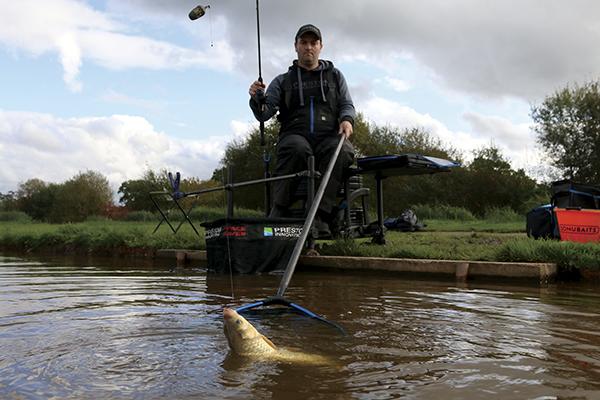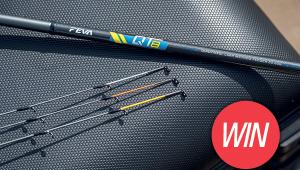Maggot Master

The maggot feeder has very much gone out of fashion in recent times. Method type feeders have become smaller and smaller and are now available in dainty little winter sizes. This has led to them being used all year round, but what has very much put the maggot feeder back on the map was last year’s Feeder Masters All-Stars match at Barston. With cool autumn weather, the Hungarian pairing of Mátyás Sivák and Tamas Walter absolutely took the event apart using maggot feeders! Since then, the maggot feeder has taken back off all over the country on commercials, and particularly venues containing plenty of F1s.
One angler who had not forgotten the maggot feeder however, is former KO Cup Winner Robbie Griffiths. One of his regular venues, Staffordshire’s Heronbrook Fisheries, has always responded well to the maggot feeder in winter, and without the restrictions of feeder-only or international rules he has agreed to reveal a number of hints and tricks to help get the best out of the old blockend!
The Theory
To get the most out of the maggot feeder, first you need to know when and why it works. First off, there is the bait itself. Maggots become the key bait on venues containing F1s once it gets really cold. Being less potent and feed rich than pellets, fish are far more likely to pick up the easily digestible wriggling little protein packets that maggots are. Not only that, but greater quantities can also be fed without killing the peg. With them becoming so dominant when fishing the pole, it’s only logical to conclude they will work well on the feeder too!
The second issue with Method type feeders is not only do they feed the wrong kind of bait, but also too much of it. When waiting a long time for bites you can get away with it, but when regularly catching fish and casting it doesn’t take long to overcook the peg. The maggot feeder is different in that there are some very small ones available that only take a very small amount of bait, and instead of continual casting being harmful, with the maggot feeder it actually helps to build the peg!
The Gear
Todays peg on Island Pool is around 20 metres wide, which is of course why the feeder rod is first out of the bag rather than a pole. Ranges just beyond the reach of a pole are actually one of the trickiest lengths to fish.
Most standard rods are just too long and powerful for these types of short casts and you often end up in a situation where the cast is far too powerful and the feeder smashes hard against the line clip and bounces back toward you. A very gentle overhead lob however, just doesn’t have the accuracy required and often the feeder ends up not going where you want it to.
My solution is to use a 10ft SL Supera rod. This super-light rod was originally designed for roach and skimmer work, but its action is not only ideal for the smaller hooks and lighter lines we use for F1s in winter, but it takes all the power out of the cast. This means I can keep the accuracy of a powerful cast without massively overshooting the target range. A 6lb Sinking Feeder mono to a 420 Magnitude reel completes the setup. Although really short hooklengths do also have their day with this approach, a longer 1½ft tail on a running rig is my opening gambit. Slightly clearer water means fish watch the bait fall through the water more and are also less likely to come right up to a feeder. A longer hooklength does away with the need for a self-hooking rig, as the longer length of line usually results in rip-roaring bites anyway. A running rig like this also means fewer tangles and no fixed feeder that the fish can potentially bounce the hook out against. The rig is just my chosen feeder threaded up the line, butted up against a line stop on top of a 3in twizzled loop. On the end of the twizzled loop is a quick-change swivel to which I attach my hooklength. To see how I tie the rig, you can view the Feature+ video by scanning the QR code on this feature with your phone. My starting hooklength is 0.12mm Accu Power to a size 18 or 16 SFL hook, which is a light setup, but strong enough to land pretty much anything when coupled with a light rod.
Be Adaptable
My feeder choice is an ICM Maggot Feeder. These come inline as standard but can be converted for use on my running rig with an ICM swivel kit. These tiny little feeders are ideal for casting just a few maggots regularly and the 12g is perfect in the calm conditions today. The 20g version comes into play with longer casts of over 30 metres or when it’s windy.
An important factor when using a maggot feeder is the amount of bait you put in it. To empty, the maggots need to actually crawl out and this process becomes even slower in cold water. To ensure they all escape quickly, don’t pack the feeder too tightly, allowing plenty of space for the maggots to wriggle and crawl out. If I’m getting indications but no actual fish, the first step I will take is to shorten the hooklength to 12 inches long. Usually this will cure the issue, but on occasions these indications will be caused by fish coming right up to the feeder.
It’s at this point that I will break the rig down and put the original inline stem back in the feeder. I could have a second rod made up, but for simplicity I usually just change my starting rod as if the inline feeder works, I will rarely revert back. The feeder is then stopped by an ICM quick change bead and a tiny 4in hooklength can be attached – while longer hooklengths will tangle on this setup, it is perfect for this.
With fish effectively hanging themselves on a longer hooklength, I think the bolt rig effect of the inline setup is needed with the shorter hooklengths. Although the feeder is still free running, a slightly stronger 0.14mm hooklength line needs to be used to brace against the weight of the much closer feeder. This isn’t an issue though, as if the fish are coming right up to the feeder they are obviously feeding confidently and will happily take the stronger setup.
The Fishing
First up, this method is very much about building up a line. Choose a line and you can keep casting on it. Although no rule is set in stone, recasting every three minutes is a good starting point. In open water, distance can be key and I will usually choose to fish longer rather than closer, but knowing the range that works best on your venue is always going to be a help.
Today’s island in front of me takes the guesswork away as tight against it will be the obvious starting point. From experience, I know that the margins are very steep in this lake so my aim is to cast as tight as possible. Although I’m trying to keep my casting tight to the same spot to build the line, searching around the peg a little to pick off extra fish can work really well. Don’t do this too often though, as spreading bait all over the place will not be productive in the long run, so make sure you always return to your original line. For bait, two pints of red maggots are usually more than enough, even for a second stealth line (more of that in a bit). Double red takes some beating on the hook, but if it is particularly hard a single can also be good but needs to be matched with a smaller size 18 hook.
As already mentioned, bites will usually result in the rod bending right round. On occasions, the tip will just sit and flicker around a little, almost as if it is waving at you. These can also be bites and only experience and trial and error with the method will enable you to determine whether to strike at these or not.
The Stealth Line
This is a tactic that I’ve picked up on recently. Although when fishing maggots at less than 16 metres the pole will usually be a better method, there are situations when the maggot feeder can score fished close in too. When fishing is particularly hard and water clear, waving a pole around and moving a bait about isn’t always best and sitting and waiting more patiently for three minutes or so at a time with a maggot feeder can be a winner. This is especially true when it’s breezy and keeping a bait still on the pole becomes tricky. This line is primed throughout the day by just catapulting a dozen maggots or so every five minutes into open water, which today is around 12 metres out. This gets fish searching around and moving about and can really throw up well later in the session when the water is at its warmest. Whatever setup has been working best long will usually be best for this line too, and I will simply use the same rod to plop my rig over the top.
Today’s Session
As if the fish were reading the rule book, the session has panned out very much like a typical winter’s day. An initially early fish on the third cast was followed by a lot of waiting. This wasn’t surprising after a cold night, but eventually things began to pick up. The odd cast off to one side did produce but most fish came after returning straight to the original line. Although there aren’t many silvers in this lake, I did catch a few roach plus a bonus perch around 1½lb. You don’t get these weight builders on a Method! Although it was flat calm so not ideal for the stealth line, it did throw up an odd fish. After four hours and around 50lb, I’ve demonstrated what the method is capable of. It’s not one for red-letter days and bagging, but when 30lb to 80lb is likely to win, the maggot feeder realy comes into its own.
- Log in or register to post comments












